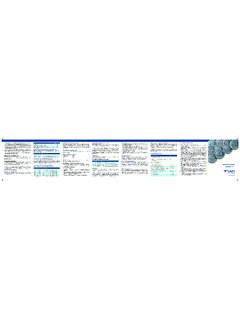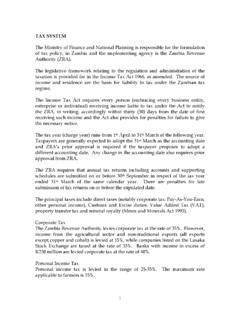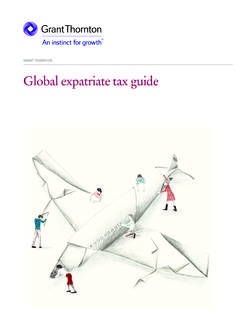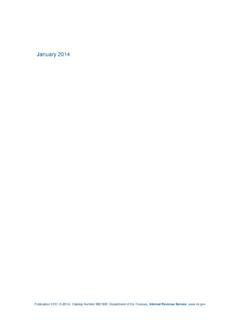Transcription of Residential accommodation RESIDENCE BASIS OF …
1 Residential accommodationThe fringe benefit to be included in gross income is the greater of the benefit calculated by applying a prescribed formula or the cost to the employerThe formula will apply if the accommodation is owned by the employer, or an associated institution in relation to the employer, or under certain limited circumstances where it is not owned by the TAX: COMPANIESF inancial years ending on any date between 1 April 2010 and 31 March 2011 TYPERATE OF TAXC ompanies28%Personal service provider companies33%Foreign resident companies which earn income from a source in South Africa 33%INCOME TAX: SMALL BUSINESS CORPORATIONSF inancial years ending on any date between 1 April 2010 and 31 March 2011 TAXABLE INCOME (R) RATE OF TAX (R) 0 57 000 0% 57 001 300 000 10% of taxable income above 57 000 300 001 and above 24 300 + 28% of taxable income above 300 000 SECONDARY TAX ON COMPANIES (STC) STC is imposed at a rate of 10% on dividends declared by resident companiesafter being reduced by dividends receivable during a dividend cycle.
2 South African branches of foreign resident companies are exempt from TAX FOR MICRO BUSINESSESF inancial years ending on 28 February 2011 Taxable turnover (R) RATE OF TAX (R) 0 100 000 0% 100 001 300 000 1% of taxable turnover above 100 000300 001 500 000 2 000 + 3% of taxable turnover above 300 000500 001 750 000 8 000 + 5% of taxable turnover above 500 000750 001 and above 20 500 + 7% of taxable turnover above 750 000 RESIDENCE BASIS OF TAXATIONR esidents are taxed on their worldwide income, subject to certain exclusions. Foreign taxes on that income are allowed as a credit against South African tax payable. This is applicable to individuals, companies, close corporations and OF CAPITAL GAINSC apital gains on the disposal of assets are included in taxable effective rate of tax:Individuals10% Companies14%Trusts20%Events that trigger a disposal include a sale, donation, exchange, loss, death and following are some of the specific exclusions.
3 R1,5 million gain/loss on the disposal of a primary RESIDENCE or the disposal of a primary RESIDENCE for an amount of R2 million or less most personal use assets retirement benefits payments in respect of original long-term insurance policies annual exclusion of R17 500 capital gain or capital loss is granted to individuals and special trusts instead of the annual exclusion, the exclusion granted to individuals is R120 000 during the year of TAXES DUTIES AND LEVIESV alue-added Tax (VAT)VAT is levied at the standard rate of 14% on the supply of goods and services by registered vendors. A vendor making taxable supplies of more than R1 million per annum must register for VAT and a vendor making taxable supplies of more than R50 000, but not more than R1 million per annum, may apply for voluntary registration. Certain supplies are subject to a zero rate or are exempt from DutyTransfer duty is payable at the following rate on transactions which are not subject to VAT Acquisition of property by natural persons:VALUE OF PROPERTY (R) RATE 0 500 000 0% 500 001 1 000 000 5% of the value above R500 0001 000 001 and aboveR25 000 + 8% of the value above R1 000 000 Acquisition of property by persons other than natural persons: - 8% of the valueEstate DutyEstate duty is levied at a flat rate of 20% on property of residents and South African property of non-residents.
4 A basic deduction of million is allowed in the determination of an estate s liability for estate duty as well as deductions for liabilities, bequests to public benefit organisations and property accruing to surviving Tax Donations tax is levied at a flat rate of 20% on the value of property donated. The first R100 000 of property donated in each year by a natural person is exempt from donations tax. In the case of a taxpayer who is not a natural person, the exempt donations are limited to casual gifts not exceeding R10 000 per annum in total. Dispositions between spouses and donations to certain public benefit organisations are exempt from donations Transfer TaxThe tax is imposed at a rate of a of a per cent on the transfer of listed or unlisted securities. Securities consist of shares in companies or member s interests in close on International Air TravelR150 per passenger departing on international flights excluding flights to Botswana, Lesotho, Namibia and Swaziland, in which case the tax is Development LevyA Skills Development Levy is payable by employers at a rate of 1% of the total remuneration paid to employees.
5 Employers paying annual remuneration of less than R500 000 are exempt from the payment of the Insurance ContributionsUnemployment Insurance Contributions are payable monthly by employers on the BASIS of a contribution of 1 per cent by employers and 1 per cent by employees, based on employees remuneration below a certain amount. Employers not registered for PAYE or SDL purposes must pay the contributions to the Unemployment Insurance INTEREST RATES RATES OF INTEREST (EFFECTIVE FROM 1 SEPTEMBER 2009)RATEF ringe benefits - interest-free or low-interest loan (official rate) or underpayment of of overpayment of provisional of tax on successful appeal or where the appeal was concededby of VAT after prescribed payment of and TAX PROPOSALS Introduce a voluntary disclosure programme during a one year window period from November 2010 Legislative amendments to address a number of aggressive tax schemes Discontinue the SITE system from 1 March 2011 Introduce a carbon emissions tax of R75 per g/km for each g/km above 120g/km on new passenger vehicles from 1 September 2010 Total fuel and road accident fund levies increase of per litre of petrol and diesel from 7 April 2010 Skills Development Levy (SDL)
6 Income TaxSecurities Transfer TaxValue Added Tax (VAT)(PAYE)Skills Development Levy (SDL)Excise Duties and Levies(SDL)(PIT)Fuel LevyUnemployment Insurance Fund (UIF)Pay As You Earn (PAYE)Pay As You Earn (PAYE)Skills Development Levy (SDL) Securities Transfer Tax (STT) Income Tax (IT)Income Tax (IT)Environmental LevySecondary Tax on Companies (STC)Transfer DutyUncertificated Securities TaxExcise Duties and LeviesRetirement Funds TaxUnemployment Insurance Fund (UIF)Fuel LevySecondary Tax on Companies (STC)Transfer DutyTurnover taxCapital Gains Securities TaxValue Added Tax (VAT)Value Added Tax (VAT)Capital Gains Tax (CGT) Environmental Levy(PAYE)Skills Development Levy (SDL)Excise Duties and LeviesUnemployment Insurance Fund (UIC)Pay As You Earn (PAYE)Securities Transfer Tax (STT) Income Tax (IT)Transfer DutyCapital Gains Tax (CGT) Excise Duties and Levies(SDL)BUDGET 2010/2011 Tax pocket guideThis SARS tax pocket guide has been developed to provide a synopsis of the most important tax, duty and levy related TAX.
7 INDIVIDUALS AND TRUSTSTax rates (year of assessment ending 28 February 2011)Individuals and special trustsTAXABLE INCOME (R) RATE OF TAX (R) 0 140 000 18% of taxable income 140 001 221 000 25 200 + 25% of taxable income above 140 000 221 001 305 000 45 450 + 30% of taxable income above 221 000 305 001 431 000 70 650 + 35% of taxable income above 305 000 431 001 552 000 114 750 + 38% of taxable income above 431 000 552 001 and above 160 730 + 40% of taxable income above 552 000 Trusts other than special trusts Rate of Tax - 40%Tax RebatesREBATESP rimaryR10 260 Additional (Persons 65 and older)R 5 675 Tax ThresholdsAGETAX THRESHOLDB elow age 65 R57 000 Age 65 and overR88 528 Provisional TaxA provisional taxpayer is any person who earns income other than remuneration or an allowance or advance payable by the person s principal. The following individuals are exempt from the payment of provisional tax: Individuals below the age of 65 who do not carry on a business and whose taxable income will not exceed the tax threshold for the tax year; or from interest, dividends and rental will be R20 000 or less for the tax year.
8 Individuals age 65 and older if their annual taxable income consists exclusively of remuneration, interest, dividends or rent from the lease of fixed property; and is R120 000 or less for the tax and dividends Interest earned by any natural person under 65 years of age, up to R22 300 per annum, and persons 65 and older, up to R32 000 per annum, are exempt from taxation. Foreign interest and foreign dividends are only exempt up to R3 700 out of the total exemption. Interest is exempt where earned by non-residents who are physically absent from South Africa for 183 days or more per annum and who are not carrying on business in South pension fund contributionsThe greater of 7,5% of remuneration from retirement funding employment, or R1 excess may not be carried forward to the following year of pension fund contributionsMaximum of R1 800 per annum. Any excess over R1 800 may be carriedforward to the following year of retirement annuity fund contributionsThe greater of 15% of taxable income other than from retirement funding employment, or R3 500 less current deductions to a pension fund, or R1 excess may be carried forward to the following year of retirement annuity fund contributionsMaximum of R1 800 per annum.
9 Any excess over R1 800 may be carriedforward to the following year of and disability expenses Taxpayers 65 and older may claim all qualifying expenditure Taxpayers under 65 may claim all qualifying medical expenses where the taxpayer or the taxpayer s spouse or child is a person with a disability. Other taxpayers under 65 may deduct monthly contributions to medical schemes up to R670 for each of the first two dependants on their medical scheme and R410 for each additional dependant. In addition they can claim a deduction for medical scheme contributions above the caps and any other medical expenses limited to the amount which exceeds 7,5% of taxable income (excluding retirement fund lump sums).Retirement fund lump sum withdrawal benefits TAXABLE INCOME (R) RATE OF TAX (R) 0 22 500 0% of taxable income 22 501 600 000 18% of taxable income above 22 500 600 001 900 000 103 950 + 27% of taxable income above 600 000 900 001 and above 184 950 + 36% of taxable income above 900 000 Retirement fund lump sum withdrawal benefits consist of lump sums from a pension, pension preservation, provident, provident preservation or retirement annuity fund on withdrawal.
10 Tax on a specific retirement fund lump sum withdrawal benefit (X) is equal to tax determined by applying the tax table to the aggregate of that lump sum X plus all other retirement fund lump sum withdrawal benefits accruing from March 2009 and all retirement fund lump sum benefits accruing from October 2007; less tax determined by applying the tax table to the aggregate of all retirement fund lump sum withdrawal benefits accruing before lump sum X from March 2009 and all retirement fund lump sum benefits accruing from October fund lump sum benefitsTAXABLE INCOME (R) RATE OF TAX (R) 0 300 000 0% of taxable income 300 001 600 000 18% of taxable income above 300 000 600 001 900 000 54 000 + 27% of taxable income above 600 000 900 001 and above 135 000 + 36% of taxable income above 900 000 Retirement fund lump sum benefits consist of lump sums from a pension, pension preservation, provident, provident preservation or retirement annuity fund on death, retirement or termination of employment due to redundancy or termination of employer s trade.















